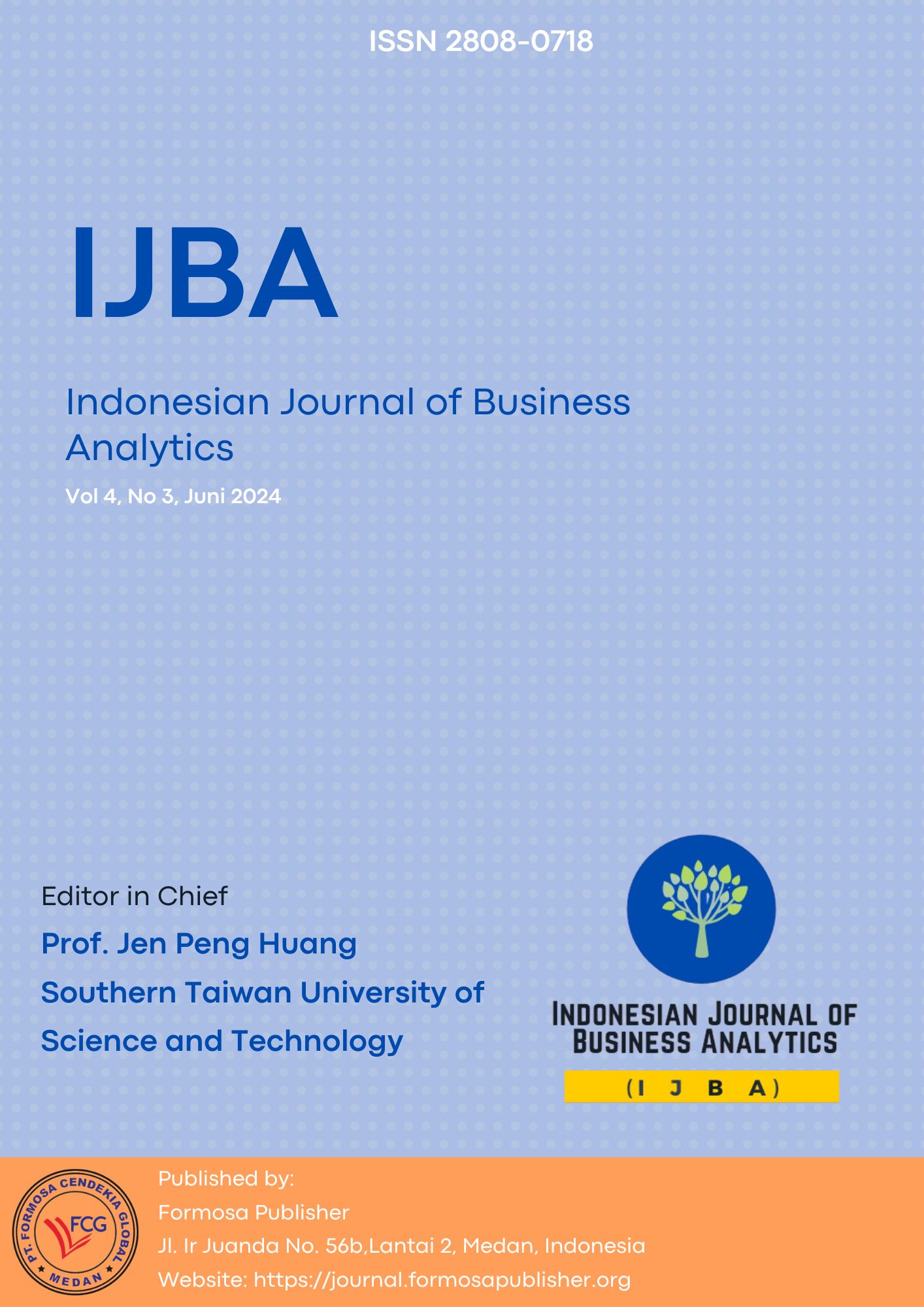Adaptation of Digital Technology in Radio Stations in Indonesia)
DOI:
https://doi.org/10.55927/ijba.v4i3.9721Keywords:
Radio Station, Digital Platforms, Digital Technology Speeds, Public EngagemenAbstract
Digital technology has had a significant impact on radio stations in Indonesia. This makes radio more accessible and allows community involvement to listen to radio broadcasts online. In addition, digital technology speeds up the broadcast process and allows the use of simulcast. This research was conducted qualitatively, using observation and literature study to collect and process data from reliable sources. Research has found that radio stations use digital technology to promote their programs and communicate with their listeners. They also use social networks to learn about public issues and increase public engagement.
Downloads
References
Bangerter, A., & Mayor, E. (2013). Interactional theories of communication. In Theories and
Models of Communication (pp. 257–271). Walter de Gruyter GmbH. https://doi.org/10.1515/9783110240450.257
Bateman, J. A. (2021). What are digital media? Discourse, Context & Media, 41.
https://doi.org/10.1016/J.DCM.2021.100502
Benjiang Lu, Z. C., & More. (2021). Live streaming commerce and consumers’ purchase
intention: An uncertainty reduction perspective. 58(7). https://doi.org/https://doi.org/10.1016/j.im.2021.103509
Bennich, A. (2024). The digital imperative: Institutional pressures to digitalise. Technology in
Society, 76(November 2023), 102436. https://doi.org/10.1016/j.techsoc.2023.102436
Bhoi, S. K., Chakraborty, S., Verbrugge, B., Helsen, S., Robyns, S., El Baghdadi, M., &
Hegazy, O. (2024). Intelligent data-driven condition monitoring of power electronics
systems using smart edge–cloud framework. Internet of Things (Netherlands),
(March). https://doi.org/10.1016/j.iot.2024.101158
Boring, E. G. (1926). Auditory Theory with Special Reference to Intensity, Volume, and
Localization. The American Journal of Psychology,
(2), 157. https://doi.org/10.2307/1413687
Bybee J; Beckner C. (2012). Usage-Based Theory.
https://doi.org/https://doi.org/10.1093/oxfordhb/9780199544004.013.0032
Chen, Y., Visnjic, I., Parida, V., & Zhang, Z. (2021). On the road to digital servitization – The
(dis)continuous interplay between business model and digital technology. International
Journal of Operations and Production Management,
(5), 694–722. https://doi.org/10.1108/IJOPM-08-2020-0544
Conti, E., Camillo, F., & Pencarelli, T. (2023). The impact of digitalization on marketing
activities in manufacturing companies. TQM Journal, 35(9), 59–82.
https://doi.org/10.1108/TQM-11-2022-0329
Fiske, J. (2010). Introduction to Communication Studies. 1–195.
https://doi.org/10.4324/9780203837382
García, Á., Bregon, A., & Martínez-Prieto, M. A. (2024). Digital Twin Learning Ecosystem: A
cyber–physical framework to integrate human-machine knowledge in traditional
manufacturing. Internet of Things (Netherlands), 25(November 2023), 1–22.
https://doi.org/10.1016/j.iot.2024.101094
Garrido-Moreno, A., Martín-Rojas, R., & García-Morales, V. J. (2024). The key role of
innovation and organizational resilience in improving business performance: A mixed
methods approach. International Journal of Information Management, 77(July 2023),
https://doi.org/10.1016/j.ijinfomgt.2024.102777
Ghosh, B. N. (2019). Dependency theory revisited. In Dependency Theory Revisited. Taylor
and Francis. https://doi.org/10.4324/9781315187389
Gilski, P., & Stefański, J. (2016). Can the Digital Surpass the Analog: DAB+ Possibilities,
Limitations and User Expectations. International Journal of Electronics and
Telecommunications, 62(4), 353–361. https://doi.org/10.1515/eletel-2016-0049
Grybauskas, A., Stefanini, A., & Ghobakhloo, M. (2022). Social sustainability in the age of
digitalization: A systematic literature Review on the social implications of industry 4.0.
Technology in Society, 70(May), 101997. https://doi.org/10.1016/j.techsoc.2022.101997
Guerra, D., Gil, U., De La Vega, D., Prieto, G., Arrinda, A., Ordiales, J. L., & Angueira, P.
(2006). Medium wave Digital Radio Mondiale (DRM) field strength time variation in
different reception environments. IEEE Transactions on Broadcasting, 52(4), 483–491.
https://doi.org/10.1109/TBC.2006.883304
Hauke-Lopes, A., Ratajczak-Mrozek, M., & Wieczerzycki, M. (2023). Value co-creation and
co-destruction in the digital transformation of highly traditional companies. Journal of
Business and Industrial Marketing, 38(6), 1316–1331. https://doi.org/10.1108/JBIM-10-
-0474
Hu, Z., Shao, X., Chen, Z., Liu, H., & Xing, G. (2012). System design and implementation of
broadband in-band on-channel digital radio. 2012 IEEE International Conference on
Communications (ICC), 4776–4781. https://doi.org/10.1109/ICC.2012.6363776
Johnson, G. (2020). HF Digital Radio Mondiale ( DRM ) Broadcast Summary Report For Long
Range Dissemination of Maritime Information. April.
Jung, J. (2017). Media Dependency Theory. In The International Encyclopedia of Media
Effects (pp. 1–10). Wiley. https://doi.org/10.1002/9781118783764.wbieme0063
Kuo, T. Z., and C. .-C. J. (2001). Audio content analysis for online audiovisual data
segmentation and classification. IEEE Transactions on Speech and Audio Processing,
(4), 441–457. https://doi.org/https://doi.org/10.1109/89.917689
Mailizar, M., Umam, K., & Elisa, E. (2022). The Impact of Digital Literacy and Social Presence
on Teachers’ Acceptance of Online Professional Development. Contemporary
Educational Technology, 14(4). https://doi.org/10.30935/cedtech/12329
Matías, J. M., Corderí, I. L., Angueira, P., Gil, U., Ordiales, J. L., & Arrinda, A. (2007). DRM
(Digital Radio Mondiale) local coverage tests using the 26 MHz broadcasting band. IEEE
Transactions on Broadcasting, 53(1), 59–68. https://doi.org/10.1109/TBC.2006.887168
Mayer, R. E. (2024). The Past, Present, and Future of the Cognitive Theory of Multimedia
Learning. Educational Psychology Review, 36(1), 1–25. https://doi.org/10.1007/s10648-
-09842-1
O’Neill, B. (2009). DAB Eureka-147: A European vision for digital radio. New Media and
Society, 11(1–2), 261–278. https://doi.org/10.1177/1461444808099578
Oxenham, A. J. (2018). How We Hear: The Perception and Neural Coding of Sound. In Annual
Review of Psychology (Vol. 69, pp. 27–50). Annual Reviews Inc.
https://doi.org/10.1146/annurev-psych-122216-011635
Oyedokun, D. M., & Ajayi, M. P. (2022). Analogue To Digital Broadcast Switchover : An
Inquiry Into The Progress , Challenges , And Benefits Of Digitising The Nigeria.
Nasarawa Journal of Multimedia and Communication Studies ( NJMCS ), August.
Özkent, Y. (2022). Social media usage to share information in communication journals: An
analysis of social media activity and article citations. PLoS ONE, 17(2 February), 1–11.
https://doi.org/10.1371/journal.pone.0263725
Parry D; le Roux D. (2020). Introducing the Media Use Behaviour Conceptual Framework.
https://doi.org/https://doi.org/10.1007/978-3-030-45002-1_15
Plekhanov, D., Franke, H., & Netland, T. H. (2023). Digital transformation: A review and
research agenda. European Management Journal, 41(6), 821–844.
https://doi.org/10.1016/j.emj.2022.09.007
Przemysław Falkowski-Gilski. (2021). Digital Transformation of Terrestrial Radio: An
Analysis of Simulcasted Broadcasts in FM and DAB+ for a Smart and Successful
Switchover. Applied Sciences MDPI, 11(11114). Https://doi.org/https://doi.org/10.3390/app112311114
Rohn, D., Bican, P. M., Brem, A., Kraus, S., & Clauss, T. (2021). Digital platform-based
business models – An exploration of critical success factors. Journal of Engineering and
Technology Management, 60, 101625. https://doi.org/10.1016/J.JENGTECMAN.2021.101625
Downloads
Published
How to Cite
Issue
Section
License
Copyright (c) 2024 Harliantara

This work is licensed under a Creative Commons Attribution 4.0 International License.







.png)

























